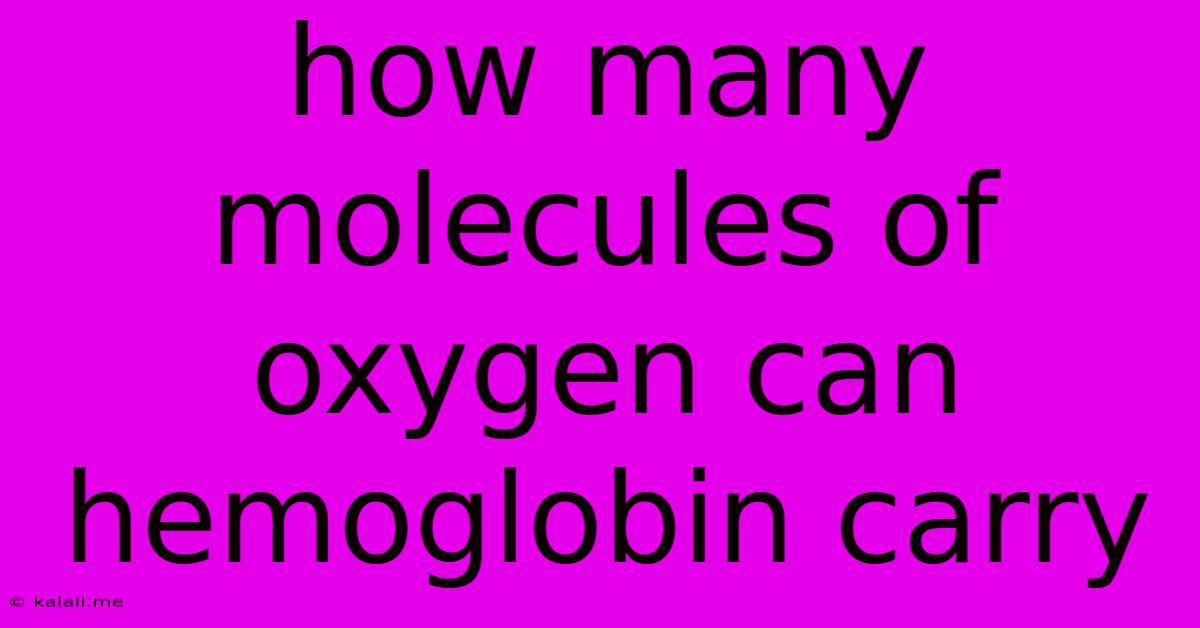How Many Molecules Of Oxygen Can Hemoglobin Carry
Kalali
Jun 15, 2025 · 3 min read

Table of Contents
How Many Oxygen Molecules Can Hemoglobin Carry? Understanding Oxygen Transport in the Blood
Hemoglobin, the protein found in red blood cells, is crucial for transporting oxygen throughout the body. Its ability to bind and release oxygen is what allows us to breathe and live. But just how many oxygen molecules can a single hemoglobin molecule carry? Let's delve into the fascinating chemistry and physiology behind this vital process.
Understanding Hemoglobin's Structure and Function:
Hemoglobin is a complex protein composed of four subunits, each containing a heme group. This heme group is the key player in oxygen binding. At the center of each heme group is an iron ion (Fe²⁺), and it's this iron ion that directly binds to an oxygen molecule (O₂).
The Magic Number: Four Oxygen Molecules
Because each hemoglobin subunit has one heme group capable of binding one oxygen molecule, a single hemoglobin molecule can carry a maximum of four oxygen molecules. This impressive oxygen-carrying capacity is vital for efficient oxygen transport from the lungs to the body's tissues.
Factors Affecting Oxygen Binding:
The efficiency of oxygen binding to hemoglobin isn't constant. Several factors influence how much oxygen is bound at any given time:
-
Partial Pressure of Oxygen (pO₂): Higher partial pressures of oxygen, such as those found in the lungs, promote oxygen binding to hemoglobin. Conversely, lower partial pressures in tissues encourage oxygen release. This is described by the oxygen-hemoglobin dissociation curve.
-
pH: Lower pH (more acidic) conditions, such as those found in actively metabolizing tissues, decrease hemoglobin's affinity for oxygen, facilitating oxygen release to the cells. This is known as the Bohr effect.
-
Temperature: Higher temperatures also reduce hemoglobin's affinity for oxygen, promoting oxygen release to tissues that are working hard and generating heat.
-
2,3-Bisphosphoglycerate (2,3-BPG): This molecule, present in red blood cells, binds to hemoglobin and reduces its oxygen affinity, enhancing oxygen release to tissues.
Clinical Significance:
Understanding hemoglobin's oxygen-carrying capacity is crucial in various clinical settings. Conditions affecting hemoglobin function, such as anemia (low hemoglobin levels) and sickle cell anemia (abnormal hemoglobin structure), can severely impair oxygen transport and lead to significant health problems. Measuring hemoglobin levels and oxygen saturation is a standard part of diagnosing and managing these conditions.
Beyond the Basics: Cooperative Binding and Allosteric Regulation:
The binding of oxygen to hemoglobin is not a simple one-to-one interaction. The binding of the first oxygen molecule to a hemoglobin subunit actually increases the affinity of the remaining subunits for oxygen. This is known as cooperative binding, and it significantly enhances the efficiency of oxygen uptake in the lungs. This is an example of allosteric regulation, where the binding of one molecule (oxygen) at one site affects the binding of another molecule at a different site on the protein.
In conclusion, while each subunit of hemoglobin can bind only one oxygen molecule, a single hemoglobin molecule, with its four subunits, can transport a maximum of four oxygen molecules. This fundamental property is essential for life, highlighting the remarkable efficiency and regulation of this vital protein. Understanding the factors influencing oxygen binding to hemoglobin offers crucial insights into respiratory physiology and the treatment of related diseases.
Latest Posts
Latest Posts
-
Carbon Shows A Very Strong Tendency To Form
Jun 15, 2025
-
Science Is The Systematic Study Of
Jun 15, 2025
-
Which Of The Following Particles Has The Least Mass
Jun 15, 2025
-
Which Of The Following Is Complex Sentence
Jun 15, 2025
-
University Of North Florida Sat Scores
Jun 15, 2025
Related Post
Thank you for visiting our website which covers about How Many Molecules Of Oxygen Can Hemoglobin Carry . We hope the information provided has been useful to you. Feel free to contact us if you have any questions or need further assistance. See you next time and don't miss to bookmark.